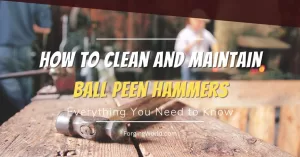Propane forges are a great way to heat metals and create beautiful pieces of art. They can be used by anyone with basic DIY skills, but it’s important to understand the basics of how they work and the safety precautions before getting started.
In this article, we will discuss the basics of how to light a propane forge and provide some tips for safely using and maintaining your forge.
Why Choose a Propane Forge?
When starting your forging journey, one of the first decisions you’ll make is choosing between a gas and coal forge. Propane forges are a popular choice for many, thanks to their efficiency, ease of use, and cleanliness. Plus, they’re perfect for knife making and forge welding.
Understanding Propane Consumption
Before we get started on lighting your propane forge, it’s essential to understand how much propane a gas forge uses. This knowledge will help you plan your work and budget accordingly.
How to Light a Propane Forge
Now that you’re familiar with the basics, let’s dive into the nitty-gritty of lighting your propane forge. This step-by-step guide will ensure you’re well-prepared for a safe and successful forge lighting experience.
1. Suit up for Safety
Before you even think about lighting your forge, make sure you’re wearing the proper safety gear. Gloves will protect your hands from heat and burns, while eye protection will shield your eyes from sparks and debris. Wear long-sleeved, non-flammable clothing to cover your skin and closed-toe shoes to keep your feet safe from hot metal. Also, ensure that your workspace is well-ventilated and free of any flammable materials.
2. Inspect Your Equipment
Before each use, give your propane forge, tank, hoses, and connections a thorough inspection. Check the propane tank for any signs of damage or rust, inspect hoses for cracks, wear, or other damage, and ensure all connections are tight and secure to prevent leaks. Addressing any issues before you light your forge will help ensure a safer forging experience.
3. Open the Propane Tank Valve
Now it’s time to let the gas flow. Slowly open the valve on the propane tank and start with a low-pressure setting to avoid sudden flare-ups. Listen for any hissing sounds that may indicate a leak. If you suspect a leak, shut off the valve immediately and check your connections.
4. Ignite the Forge
With the propane flowing, it’s time to bring your forge to life. Use a long-reach lighter or igniter to avoid burning your hand and position the flame near the burner port to ignite the propane. Listen for the “whoosh” sound as the propane ignites and the forge comes to life.
5. Adjust the Flame
Once your forge is lit, you’ll want to fine-tune the flame to suit your needs. Adjust the propane flow using the regulator on the tank to control the flame’s intensity. Control the air intake on the burner to achieve the right fuel-to-air mixture for optimal heat. Aim for a propane forge temperature appropriate for the metal you’re working with and your specific project.
6. Monitor and Maintain
With your forge up and running, it’s important to keep an eye on things. Regularly check for leaks around the propane tank, hoses, and connections, and make sure the forge is burning cleanly and efficiently. Adjust the flame and air intake as needed to maintain the desired temperature.
FAQs About Lighting a Propane Forge
Here are some frequently asked questions about lighting a propane forge to help you better understand the process and address any concerns.
Is it safe to light a propane forge indoors?
While it is possible to use a propane forge indoors, it is crucial to ensure that the space is well-ventilated and free of flammable materials. Additionally, installing a carbon monoxide detector is highly recommended for added safety.
What should I do if I smell propane or suspect a leak?
If you smell propane or suspect a leak, immediately shut off the propane tank valve, extinguish any open flames, and ventilate the area. Inspect your equipment for any visible damage or loose connections. If you cannot identify the issue, consult a professional for assistance.
Can I use a regular lighter to ignite my propane forge?
It is recommended to use a long-reach lighter or igniter to light your propane forge. This will help keep your hand at a safe distance from the flame, reducing the risk of burns.
How do I know if my forge is burning efficiently?
An efficiently burning propane forge will produce a steady, blue flame with minimal yellow or orange flickering. Adjusting the propane flow and air intake will help you achieve an optimal fuel-to-air mixture for a clean, efficient burn.
How long does it take for a propane forge to reach forging temperature?
The time it takes for a propane forge to reach forging temperature will depend on factors such as the forge’s design, insulation, and burner performance. Generally, a propane forge can reach forging temperatures within 5 to 15 minutes.
Can I use a propane forge for forge welding?
Yes, propane forges can be used for forge welding. It’s essential to maintain the correct temperature and use flux to facilitate the forge welding process.
What should I do after I’m done using my propane forge?
When you’ve finished using your propane forge, follow these steps:
- Turn off the propane tank valve and let the forge cool down.
- Disconnect the propane tank from the forge.
- Inspect your equipment for any signs of wear or damage.
- Store your propane tank and forge in a cool, dry, and well-ventilated area.
Final Thoughts
Learning how to light a propane forge safely is an important part of the forging process. Armed with this knowledge, you’ll be ready to get started and make some beautiful pieces of art.
Just remember to keep your workspace safe, inspect your equipment beforehand, and monitor the flame throughout your projects for optimal results.



